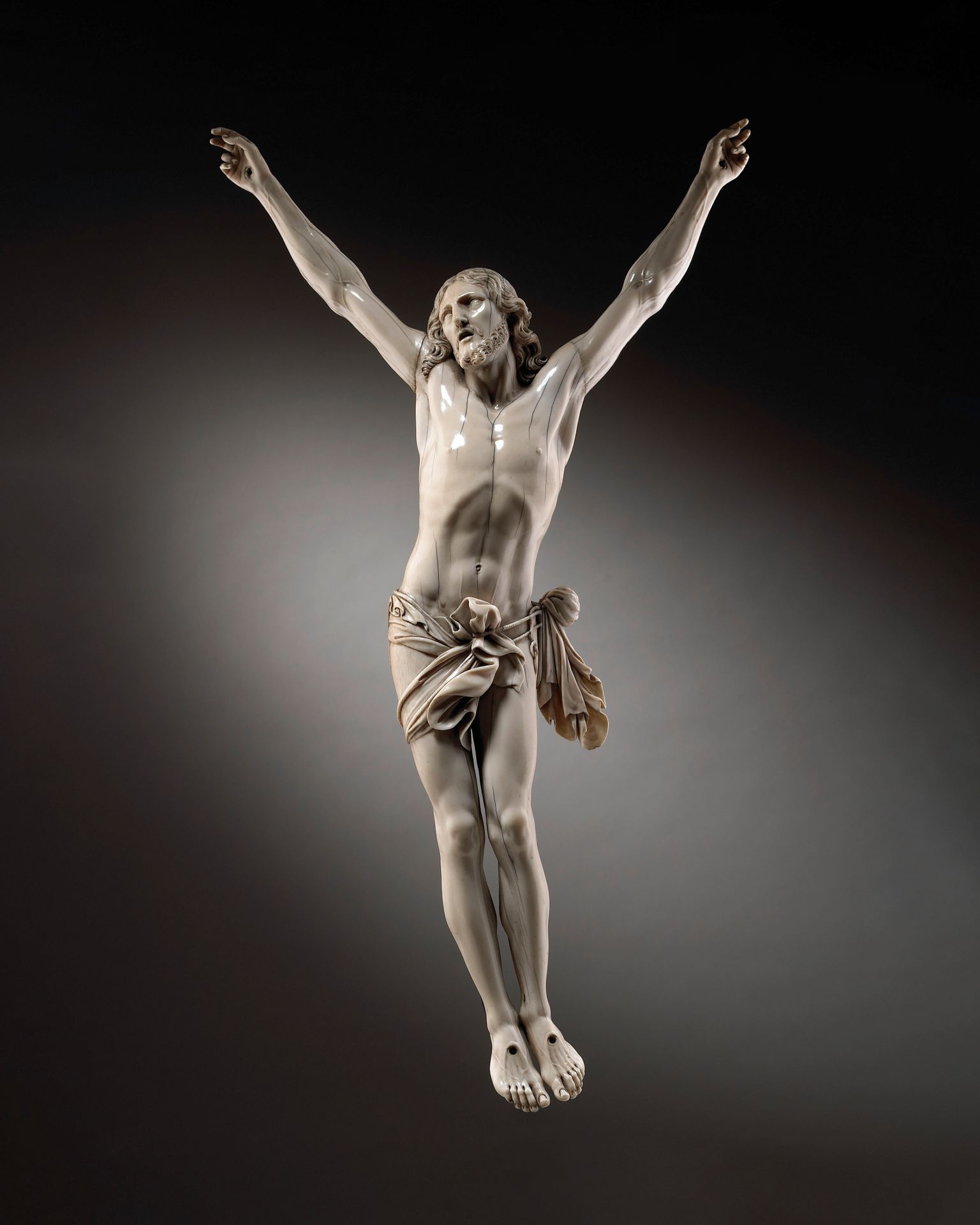Description
CHRIST EN CROIX France, XVIIIe siècle Ivoire 59 x 32,5 x 7 cm Ce corpus en ivoire représente le Christ sur la croix en agonie, la tête légèrement penchée en arrière repose sur son épaule droite. Son abdomen, dont l’anatomie est finement travaillée dévoile chacun de ses muscles, ses côtes et ses veines. L’absence de plaie sur son flanc droit indique que cette représentation préfigure le moment où le Christ est transpercé par la lance du centurion Longinus. Son visage d’une grande délicatesse, offre au spectateur les traits fins et définis du Sauveur. Sa souffrance arrivant au paroxysme est retranscrite par son regard agonisant et sa bouche béante. Les cheveux et la barbe sont finement sculptées, donnant une impression de mouvement contrastant avec la posture du corps figée sur la croix. L’allure générale du corps est longiligne - les bras sont eux aussi finement détaillés, notamment par la présence des veines apparentes, les stigmates aux mains et au pieds ainsi que les détails des phalanges sont d’une grande finesse et témoignent d’une exécution de grande maîtrise. Enfin le travail du drapé nous offre une illusion de mouvement toujours d’une grande finesse. CORPUS CHRISTI France, 18th century Ivory 59 x 32,5 x 7 cm This ivory Corpus represents Corpus Christi in agony, the head slightly backwards rests on his right shoulder. His abdomen, whose anatomy is finely crafted, reveals each muscles, ribs and veins. The absence of a wound on his right flank indicates that this representation foregoes the moment when the Christ is pierced by the lance of the centurion Longinus. His face of great delicacy offers the viewer the fine and defined features of the Savior. His suffering reaching paroxysm is transcribed by his dying gaze and his gaping mouth. Hair and beard are finely sculpted, giving an impression of movement contrasting with the posture of the body pinned on the cross. The general appearance of the body is slender - arms are also finely detailed, in particular by the presence of the visible veins, the stigmata on the hands and feet as well as the details of the phalanges are of great finesse and testify an execution of great mastery. Finally, the work of the covering drape offers us an illusion of movement that is always of great finesse.
72
CHRIST EN CROIX France, XVIIIe siècle Ivoire 59 x 32,5 x 7 cm Ce corpus en ivoire représente le Christ sur la croix en agonie, la tête légèrement penchée en arrière repose sur son épaule droite. Son abdomen, dont l’anatomie est finement travaillée dévoile chacun de ses muscles, ses côtes et ses veines. L’absence de plaie sur son flanc droit indique que cette représentation préfigure le moment où le Christ est transpercé par la lance du centurion Longinus. Son visage d’une grande délicatesse, offre au spectateur les traits fins et définis du Sauveur. Sa souffrance arrivant au paroxysme est retranscrite par son regard agonisant et sa bouche béante. Les cheveux et la barbe sont finement sculptées, donnant une impression de mouvement contrastant avec la posture du corps figée sur la croix. L’allure générale du corps est longiligne - les bras sont eux aussi finement détaillés, notamment par la présence des veines apparentes, les stigmates aux mains et au pieds ainsi que les détails des phalanges sont d’une grande finesse et témoignent d’une exécution de grande maîtrise. Enfin le travail du drapé nous offre une illusion de mouvement toujours d’une grande finesse. CORPUS CHRISTI France, 18th century Ivory 59 x 32,5 x 7 cm This ivory Corpus represents Corpus Christi in agony, the head slightly backwards rests on his right shoulder. His abdomen, whose anatomy is finely crafted, reveals each muscles, ribs and veins. The absence of a wound on his right flank indicates that this representation foregoes the moment when the Christ is pierced by the lance of the centurion Longinus. His face of great delicacy offers the viewer the fine and defined features of the Savior. His suffering reaching paroxysm is transcribed by his dying gaze and his gaping mouth. Hair and beard are finely sculpted, giving an impression of movement contrasting with the posture of the body pinned on the cross. The general appearance of the body is slender - arms are also finely detailed, in particular by the presence of the visible veins, the stigmata on the hands and feet as well as the details of the phalanges are of great finesse and testify an execution of great mastery. Finally, the work of the covering drape offers us an illusion of movement that is always of great finesse.
